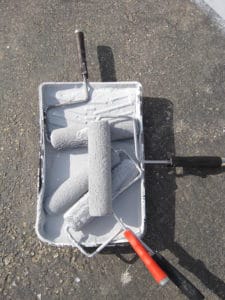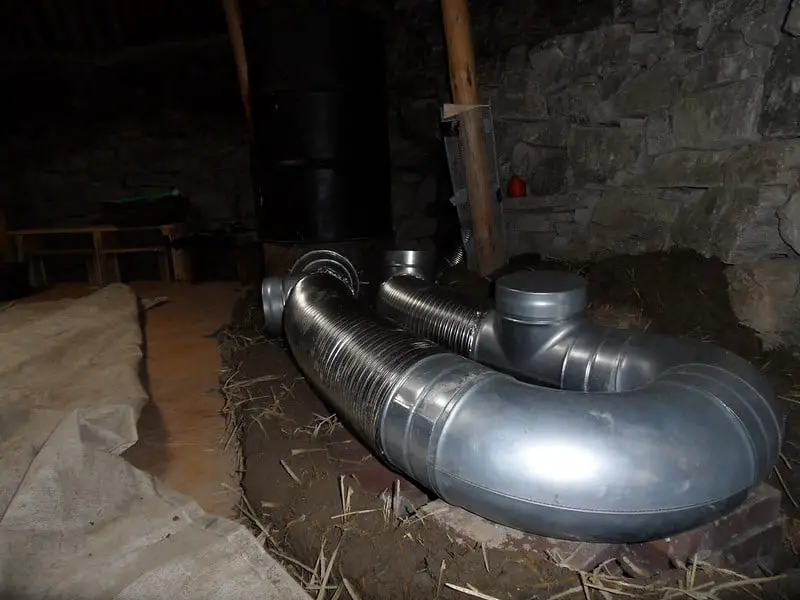Many manufactured homeowners love the industrial look of exposed ductwork.
Although most ducts have a shiny silver appearance, your ductwork can be unsightly depending on where it is installed.
If you find the exposed ductwork in your manufactured home distasteful or just dislike the raw look it gives your rooms, you may consider spruce up the ducts.
So, Is It OK To Paint Manufactured Home Ductwork?
Yes. If you don’t like the raw look of exposed ductwork, painting the ducts can be a great way to give them a new desired appearance. Painting ductwork offers one of the most inexpensive and fastest ways to conceal ducts and pipes running through your manufactured home. However, you need to use the right type of paint to achieve excellent results.
Exposed ductwork is a holy grail for industrial style. While many people choose to paint ducts to blend with the background wall or ceiling, you can opt to contrast it. With a unique paint, you will highlight the ductwork, giving it an appealing look so that it speaks your style.
Are you planning to redecorate your manufactured home?
Having your ductwork painted can be a great way to match the ducts with the ceiling or wall, so they faintly disappear.
Whether you like exposed ductwork or not, painting offers an ultimate way to hide or highlight ductwork.
What is ductwork?
Also known as a duct system, ductwork is a network of ducts that distributes air from your heating, ventilation, and air conditioning (HVAC) equipment throughout your manufactured home. Basically, these networked conduits ensure acceptable and ideal indoor air quality while enhancing thermal comfort.
Ducts can either supply air, return air, or exhaust air to keep your manufactured home ventilated.
For effectiveness, you must ensure the ductwork is installed correctly and well maintained.
The ductwork facilitates temperature control and moves stale air throughout the space simultaneously to keep occupants of your home free from respiratory ailments.
Two Ways Of Dealing With Exposed Ductwork

Before painting exposed ductwork in your manufactured home, you need to decide whether you want to hide or highlight the duct system.
Most ducts used in manufactured homes are made from galvanized metal, featuring a shiny silver look.
The easiest, cheapest, and, indeed, the most common way to deal with ductwork is leaving them au natural.
They allow you to enjoy a raw, industrial atmosphere.
However, for whatever reason, you may consider incurring small costs and paint your ductwork.
1. Camouflage Or Match The Current Theme?
When painting ductwork, you can choose to camouflage the ducts or paint them to match the existing theme of your manufactured home.
You can treat the exposed ductwork as an accessory and paint it with your favorite eye-catching color.
Matching it with one or more of your manufactured home appliances camouflages the industrial look without making them disappear.
2. Match The Color Of The Ceiling Or Walls?
Another great way of dealing with exposed ductwork is painting them to match your ceiling or walls.
This will immensely depend on where the ducts are installed. Ideally, coordinating ductwork and ceiling or wall is meant to make the ducts disappear into the background.
Painting a duct system can help even the most dominant ductwork to faintly fade into the background.
Depending on where your duct is installed, it can be purely functional, or you can paint it to serve an aesthetic purpose.
Painting a duct system is an excellent option to camouflage the ductwork, especially if you dislike the industrial look given by exposed ductwork.
How To Paint A Duct System (Galvanized ductwork) In Four Steps

Galvanized metal duct systems are designed to provide a raw and natural vibe, thanks to their silver color.
However, you will want to paint your ductwork for various reasons and give it a new look and bring extra glitz to your space.
Before starting duct work, keep in mind that zinc forms a thin film of dust, which must be cleaned before painting.
Again you need to use the correct paint. Here are the steps to paint ductwork.
Step 1: Prepare the surface.
All galvanized metal duct worms need to be cleaned thoroughly before painting.
Although galvanizing makes ducts rust-resistant, zinc is reactive and oxidizes to create a dust film that can hinder the paint from adhering properly.
The thin film necessitates thorough cleaning before painting.
Thankfully, this is very easy.
To clean your galvanized ductwork, moisten a microfiber rag with denatured alcohol or spirits. While some ductwork can be cleaned with water and soap, others will require powerful cleaners like white vinegar.
Wiping the ducts with a damp cloth will remove greasy, dust, dirt, and other debris on the conduits you want to paint. Cleaning makes the surface more receptive to paint by removing the debris that could otherwise hinder paint adhesion. After cleaning the passages, allow them time to dry.
Step 2: Apply a primer.
A primer is primarily meant to help the paint adhere to the surface of ducts.
Because most ducts get hot, you may consider applying a high heat-resistant primer. Conventional primers are designed to withstand 120℉, but with extra efforts, you can get a unique primer that can withstand 300℉ or more.
Place drop cloths underneath all your ductwork and use a synthetic bristle paintbrush to apply acrylic latex metal primer on the ducts.
To avoid brush marks, you can spray the primer with an aerosol can. Depending on the primer you choose, allow it to dry first least two hours.
Note: Primer and paint may take longer than usual to dry if your ductwork is located in the basement or other moist areas.
Step 3: Paint the ductwork (first coat)
Paint ductwork with the desired color – when painting a galvanized duct system, it is best to use latex paint.
For ducts located in an out-of-the-way place, it will be okay if you use a paintbrush.
However, if the flue is in a prominent space, spray paint becomes a better option. Apparently, spray painting gives excellent results.
If you opt to spray the paint, you need to mask all other surfaces that you don’t want to be painted using plastic sheeting.
Depending on whether you want to hide the ducts or give them an outstanding unique appearance, you will choose the correct color.
For aesthetics, you may consider painting your ductwork to match various appliances.
After applying the first coat, allow the surface to dry, preferably overnight. Make sure to check the manufacturer’s instructions to know how long the paint will take to dry.
Step 4: Apply a second coat.
After the initial coat has dried, you can apply the second coat. With ductworks, you don’t need to sand the surface between coats.
You can add more coats to make the paint layer thicker.
When painting, check if there are any strict guidelines to ensure precise conformity, especially if you have considerably heavy ductwork in your manufactured home.
Allow the second coat to dry and admire your hard work. Although ducts get hot, they barely get too hot to require high-temperature paints.
Therefore, it is okay to use conventional flat, semi-gloss, or high gloss acrylic latex paints. To be sure, you can ask for recommendations from family and friends.
Four Benefits Of Painting Ductwork
Painted or not, ductwork comes in various materials, sizes, shapes, and styles for visual aesthetics.
1. Conceal imperfections
Besides camouflaging the duct, painting ductwork helps blend ceiling or wall imperfections.
By painting your ductwork to match ceiling or walls hides where the walls meet duct.
Painting hides imperfections while adding something interesting to your rooms.
2. Makes a room feel decluttered
Most manufactured homeowners paint duct systems to hide them on top of matching them with the ceiling.
If you paint your ducts with a bright color, they reflect light; therefore, making your rooms brighter and feel bigger.
Besides, bright colors please the eyes without making your space feel overwhelming.
3. Painting ductwork enhances visual appearance
When painting ducts in your manufactured home, you can decide to have fun with them and give them a bold accent look.
Instead of buying designed ductwork, you can install ordinarily-designed ductwork and paint it to add an appealing visual impact.
4. It is a cheaper way to hide ducts
If you dislike the raw industrial look of exposed ductwork, painting offers the most inexpensive way to hide those unsightly pipes.
All you need is to buy a high-quality acrylic latex paint and paint it yourself.
Compared with all other methods used to hide exposed ductworks, it is the least expensive and less labor-intensive.
Painting keeps away rust and other particulates that would cause wear; therefore, prolonging the lifespan of your ducts and the duct system altogether.
Related: Is It Better To Paint Your Home Yourself Or Just Hire Someone To Do It?
Conclusion
Whether installed in your basement or elsewhere in your manufactured home, ductworks can give an unpleasant look.
Painting your ductworks gives them a new look; therefore, adding a dash into your manufactured home.
When painted correctly, ductworks can maintain their remarkably pleasing appearance for over ten years without peeling or any other problems.
For whatever reason you consider painting your ductworks, it is an excellent way to camouflage ducts while giving your rooms an intriguing looks.

